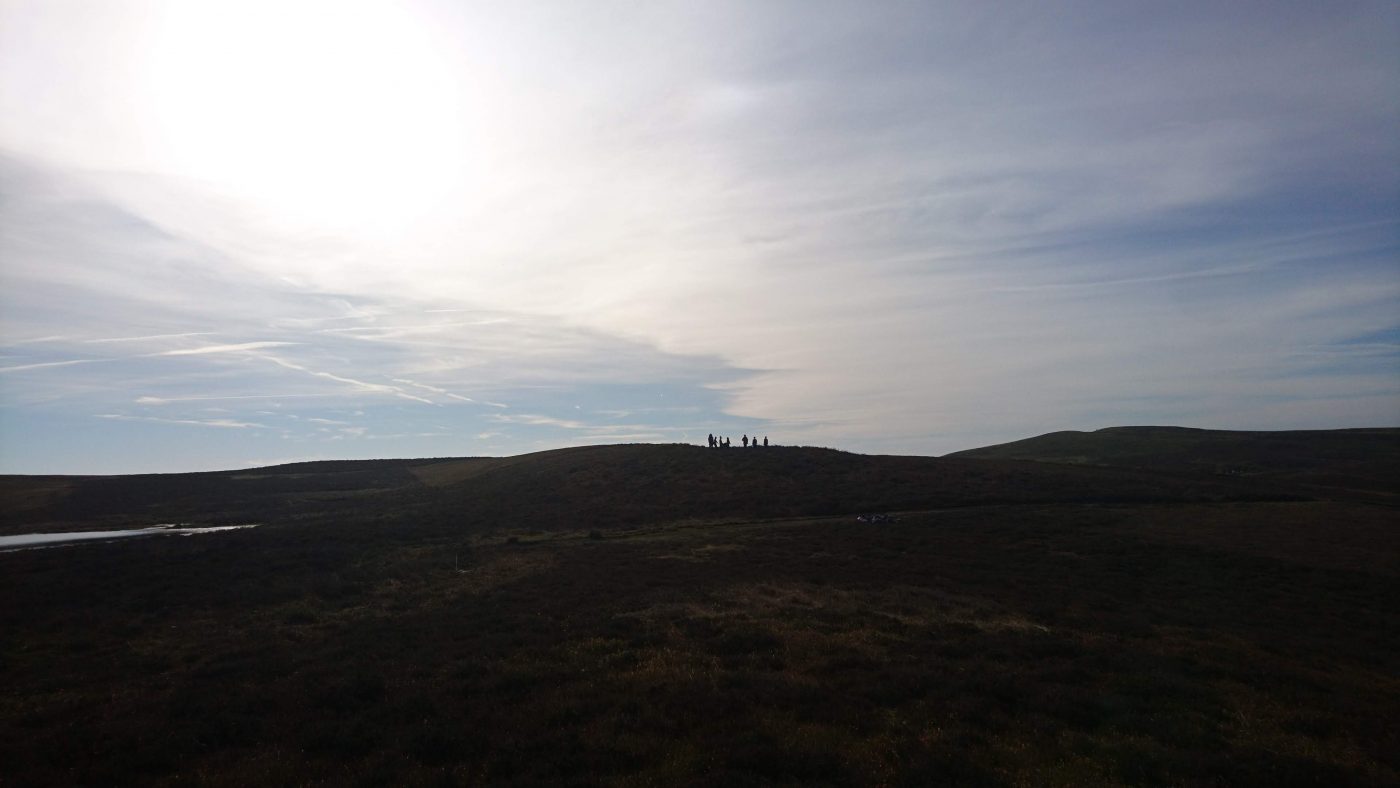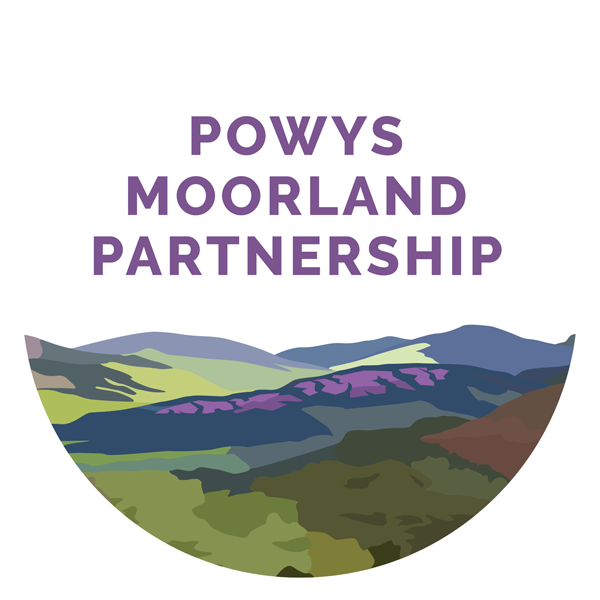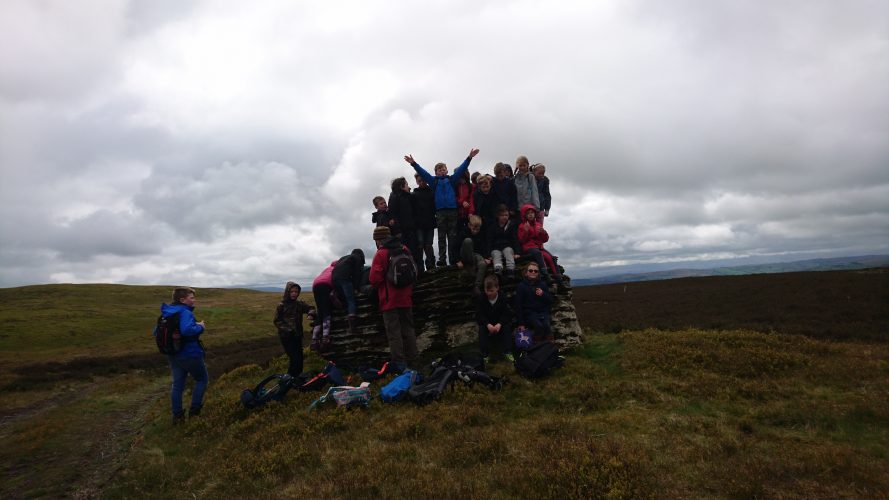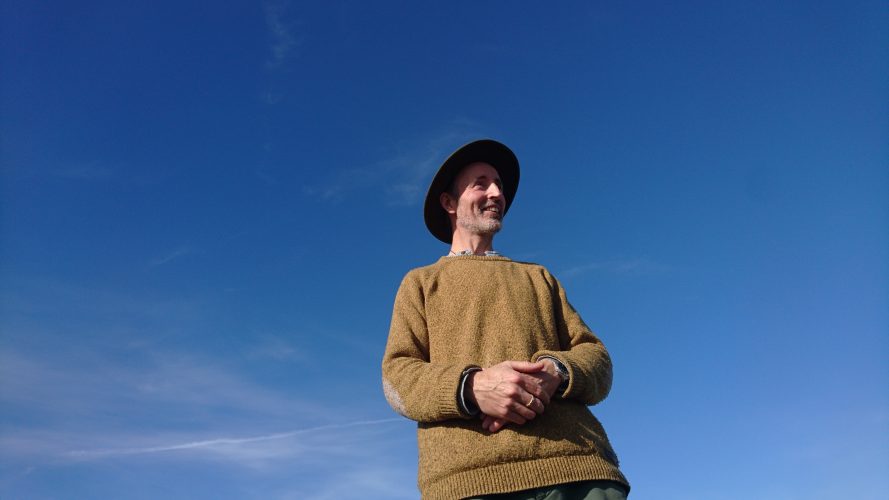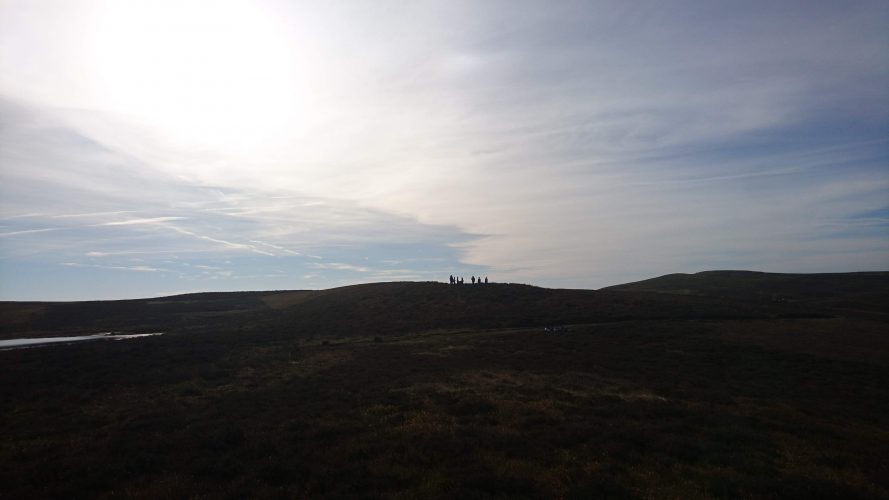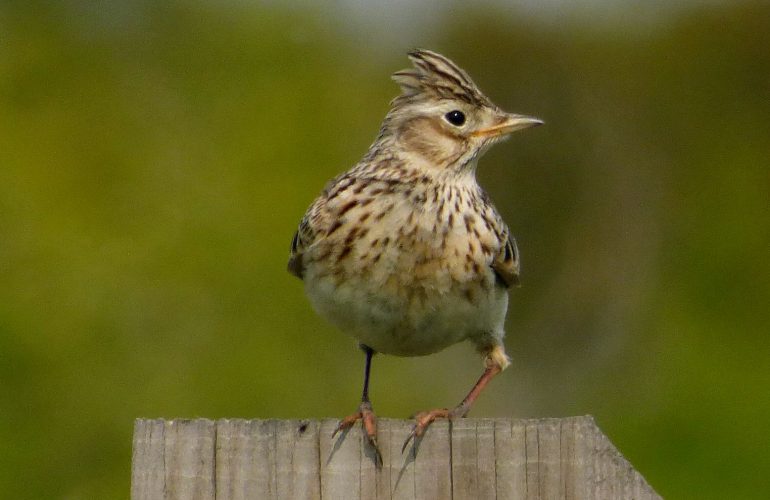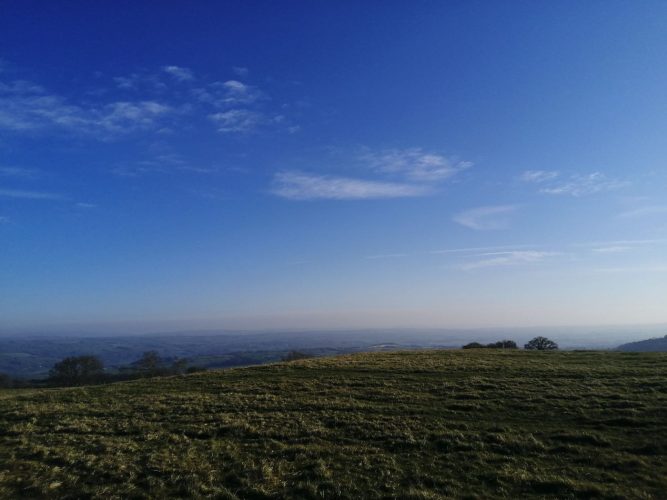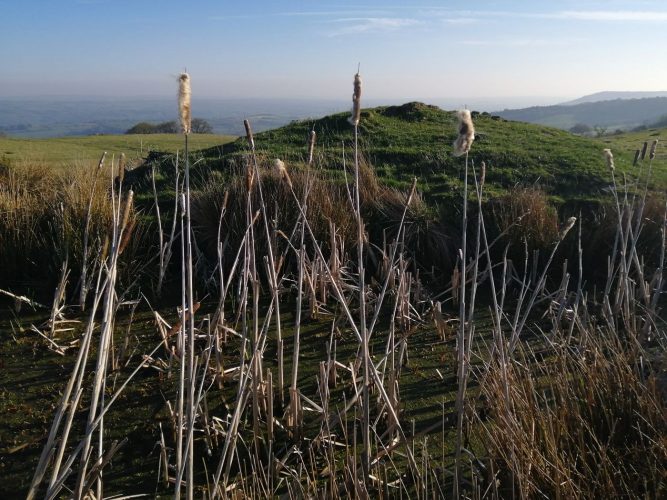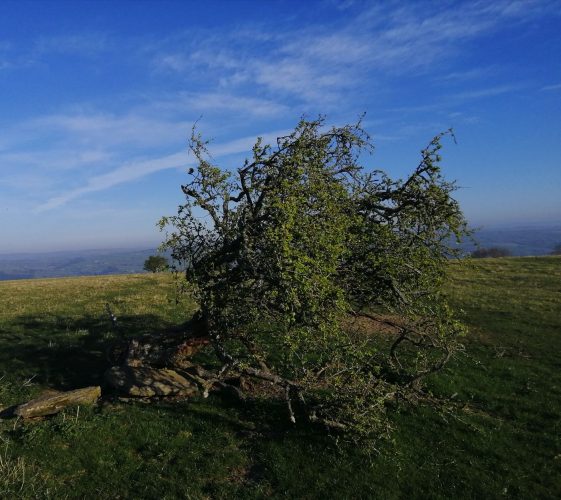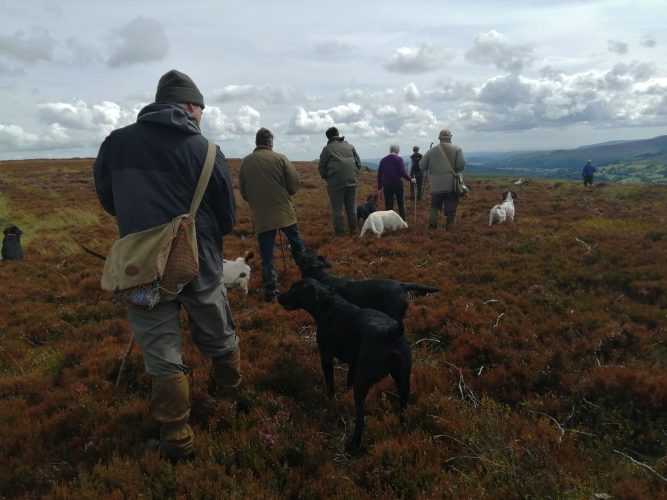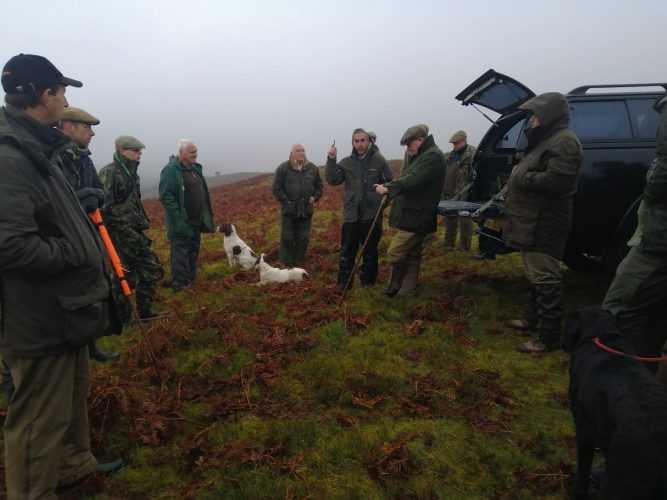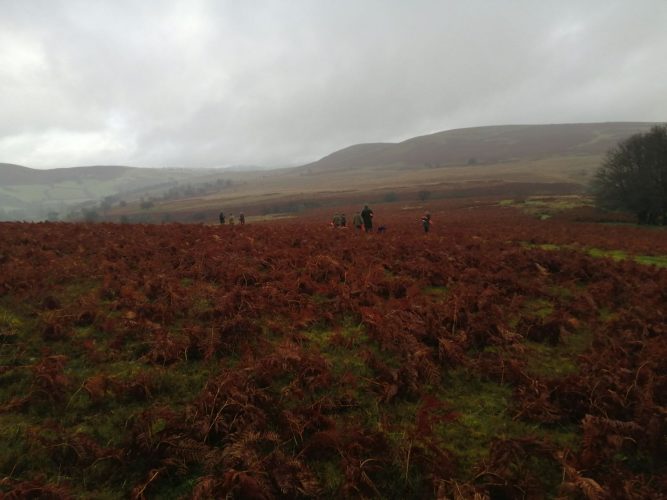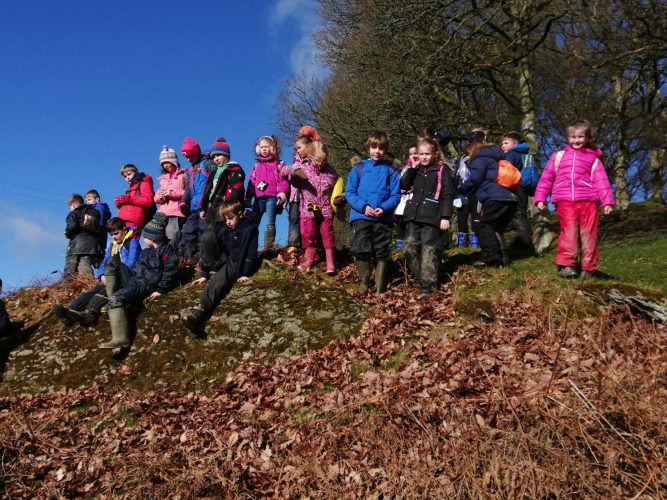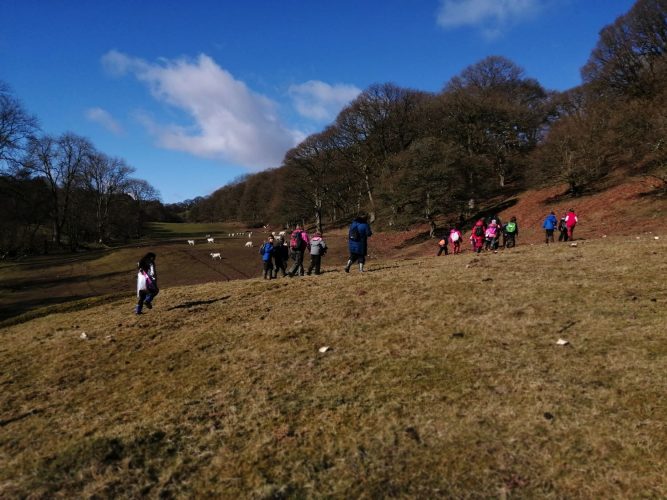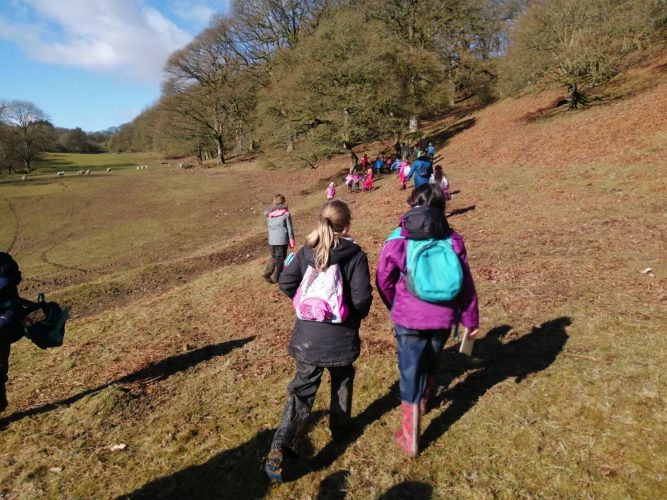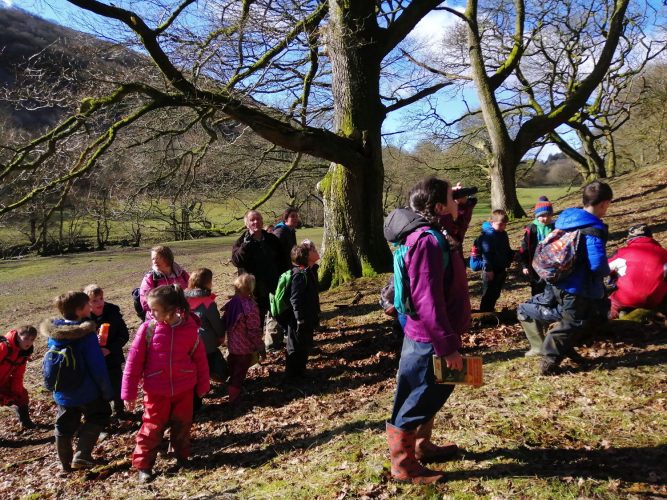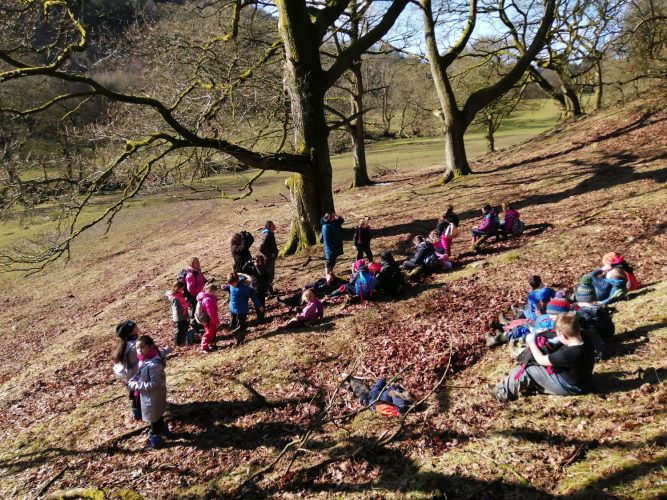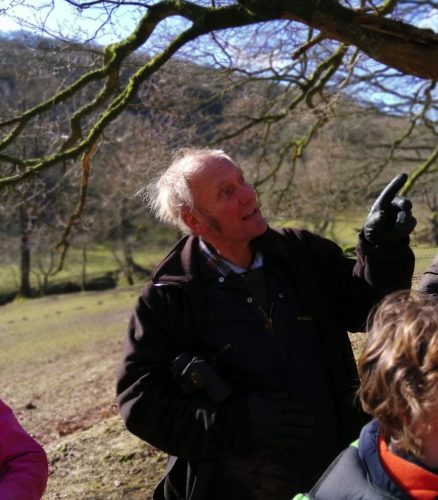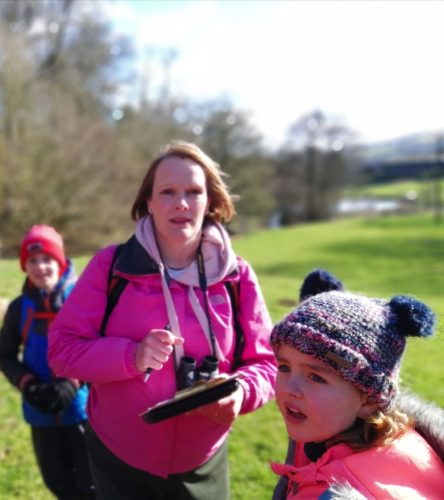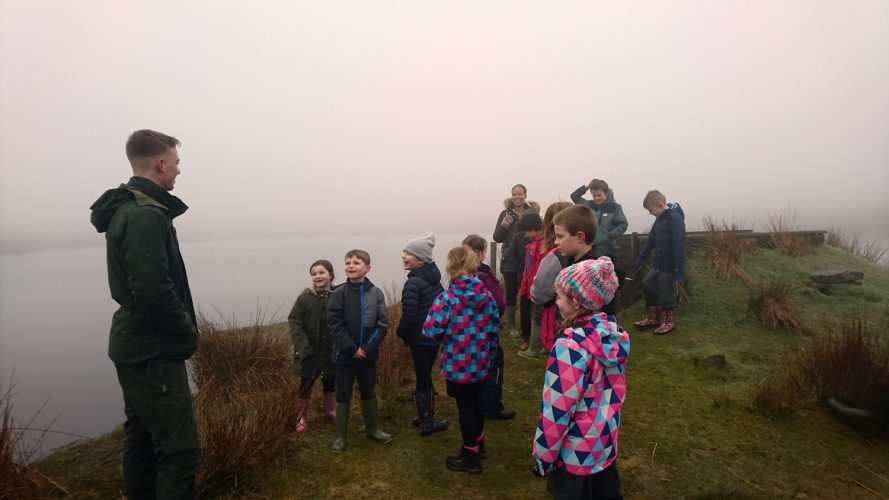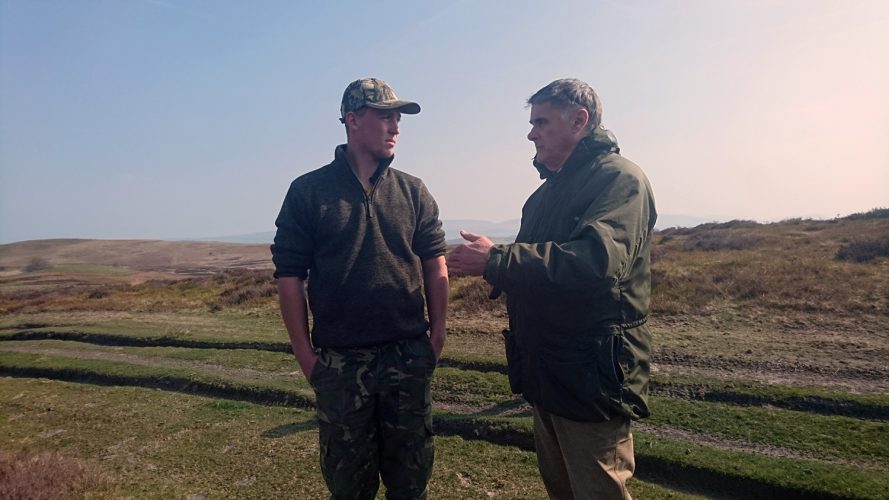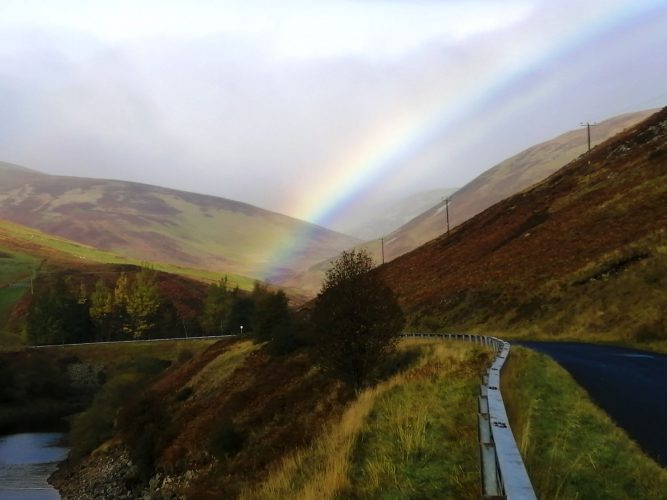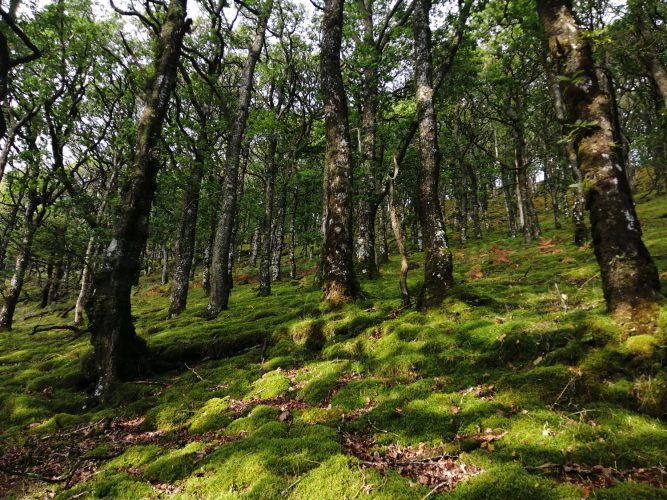Making better connections, understanding ourselves and our relationship with nature through the power of storytelling is what Wayland Boulanger does.
A great follower of the Mabinogion where its tales cleverly link with the complexities of our landscapes, fitting perfectly into the ethos of the Sustainable Management Scheme project in how we capture communities in our landscapes to try to see where we can come together, share values and find a new level of respect.
“It’s about making connections and recognising how we are all more connected than we think,” says Wayland, who believes the tales give permission to think differently with complete freedom to help children slip into another world and access wisdom for themselves.
“It’s not about finding a right or a wrong way to think. It’s up to each individual to see the story, explore the opportunities and unravel the task of the tales for themselves and put it into their own perspective.”
The old old tales of the Mabinogion are as relevant today as when they were written many years ago when connections were more in tune and where folk relied on the signs from nature to help them understand themselves and their environment better. The tensions, the struggles, the boiling pots; the compromises, the way to work it out better together.
Stepping out of the world into another where you can be something else, albeit for just a moment in time, is where you can make better sense of your own place is what Wayland believes the Mabinogion inspires.
The children both from Hay and Clyro school were captivated by the tales as they stepped into the tales of the Mabinogion and walked/ran across the moor turning the landscape it into a live stage performance as Wayland headed off to the next point of the hill to continue the story to further stir the imagination.
A magical experience where the weather wasn’t even noticed. In fact,
the wind and rain is all part of the experience. The children are enthralled by the ‘what happens next’ in the stories so beautifully told by Wayland.
It’s a way of understanding ourselves better too. In lots of ways it’s simple, uncluttered not motivated by any religion. It’s balancing the ying and the yang, it’s about life experiences. The tales are somehow pointing to the equilibrium; the balance.
“It completely awakens something up inside of us,” explains Wayland, who believes that there is a buzz going on right now. There’s something much deeper going on in our landscapes which is calling out for connections to be made.
We are again entering another world for a moment, exploring ourselves, and making sense of the ever-changing world. We must connect with the country people to help us bring greater cohesive into our landscapes. The wisdom in nature is what will reunite people.
The old values are waiting to be connected …………
The Mabinogion is really about facilitating bigger conversations allowing for the more discerning view to help a new level of respect being born.
The sound of Moorlands
Listen to the skylarks on the Moorlands in April
The skylarks songs are hard to miss on the Moorlands as they’re everywhere but the birds themselves are much harder to spot in the landscape.
The skylarks are small and brown and hide pretty well. You can find them on farmland, grassland, heathland as well as moorlands. They are endangered since their recent and dramatic population decline and are now on RSPB’s Red List.
Beaters day
“Being so accepted by a community made up of such a diverse group of people was really humbling,” says Sharon, who joined in on her first ever beating season last autumn on one of the moors involved in the Powys Moorland Partnership project which operate a shoot. She has also just done a season lambing too.
Coming from a farming background in Somerset, Sharon – who left home at 18 and trained to be a chartered accountant in London for 15 years – has always wanted to get better connected to her surrounding landscape in Hay, and now that her children are older, she has rolled up her sleeves and got involved.
Although she wasn’t sure what to expect, she can’t emphasise enough how welcomed she was made to feel from the beating community – who flush birds in the direction of the guns on a shoot day – and who come from all walks of life.
“Their lives, stores, their jobs – many of which I never knew existed – has been absolutely fascinating,” she says, adding how touched she was in how interested they were in her.
“They explained everything to me and helped me understand what happened during the day. I quickly saw how they were often immersed in sometimes the cruelest of weather,” she says, adding that to many it’s a way of life, and a way of keeping a safe food supply ready in the freezer. “Also inspiring to see many youngsters out too,” she says.
The stunning ever-changing landscapes are amazing, explains Sharon, who witnessed the constantly changing views as the clouds danced in the skies as they covered miles of ground across the heather moorland.
“Being outside all day in all weathers with no protection makes you feel alive, aware of all your senses. One day I was sunburnt, with dust in my eyes, the next I was drenched in rain and covered in mud. You feel part of the elements, she says. It’s a powerful feeling that takes your mind somewhere else. And then it was the feeling when you got home. The exhaustion, the permission to sit down and relax, such a treat. A welcome feeling.
Sharon admits that shooting birds isn’t something she is comfortable with, but getting involved has opened her eyes as to why it happens and why income from the guns is needed. It’s quite brutal out there with all the challenging from the predators for both the ground nesting birds and the sheep and I guess the need to strive for a balanced countryside is well illustrated.
“I know, after helping with the lambing, how heartbreaking it is to lose lambs when you spend so much time with them to help them get a good start.
“I was again made very welcome on the farms I helped lambing on this spring and again so humbled to be trusted to help with so many of the jobs. The hours that they work and the little sleep that they had was an eye opener,” says Sharon, who is so pleased that farmers have been recognised as key workers in the current coronaVirus situation.
Sharon now feels that she has two markers in her diary, autumn and spring. “It makes me feel closer to the seasons and feel part of the landscapes around me where so much is going on. I feel connected, even liberated. I feel that my life has more depth thanks to the farmers and the gamekeepers. I also feel fitter and I even look forward to putting my head back into the books to do the accounts!”
It’s time to listen!
I just want to get my hands on Welsh Wool which I’m surrounded by…but I’m not allowed to!!!
It’s taken the lockdown to listen a bit more to what is really being said. Facilitating the PMP for its 3 year term has involved lots of conversations around sustainability. But as in most cases we rarely hear what people are saying. I’m always on to the next thing to see if I can make sense of the key words: building resilience into landscapes, reconnecting communities, creating wildlife corridors etc. Yet some of the easiest wins are staring us in the face as usual and are probably the most powerful in getting more people connected and linked with the surrounding landscape.
The Welsh Girl – based in Hay – and I have chatted to a lot over the years and it has only been now – during lockdown – that I have actually heard what she is asking for. ‘Why can’t I have Welsh Wool to produce my wool products when there is so much here on my doorstep, she pleads,”?
Julie Leonard is The Welsh Girl https://thewelshgirl.com/ and she has always fascinated me with her unique creativity which is glaringly apparent when you enter her shop at St John’s Place. Her work is all about regenerating the textiles of Wales. Ponchos, bags, scarves and homewares all handmade from traditional Welsh tapestry. The cloth is woven especially for her on traditional looms where only small runs are produced and no two colour combinations ever repeated.
She works hard, works with Welsh people and spreads the word worldwide of what her Welsh story is all about. Beautiful Wales, renowned for its millions of sheep, plus all the rain of course and the masses of naturally grown grass surrounded by the stunning mountains; used to illustrate so many postcards, paintings/books: yet she can’t get her hands on the wool. In fact she has to get it from a company in Yorkshire where the British Wool Board is based.
Welsh wool??? It’s one of the first questions asked when they come into the shop and the look of puzzled faces puts me on the back foot immediately, says Julie, who’s self-employed, leaving a well paid job in Production in London after 25 years to return home, admits it’s deeply frustrating.
Especially so, as it’s such a simple link to connect the landscape with the people, it opens up the whole story of our natural resources and how we use them and how interlinked we all are. “We are more connected than we think,” she says, adding that The Welsh Girl is about generating new skills, stimulating the local rural economy, connecting people with the farmers and educating future generations. It’s what sustainability is all about, says Julie.
In fact I find myself constantly apologising that with all the sheep they have passed on their way into Hay, none of them are connected to the beautiful array of products that Julie has made. Many people visit Hay, both from home and overseas, and people cannot understand why Welsh wool is not used.
For Julie, it’s not about money, or profit, or drumming up value so that it can be sold, it’s a passion and of course a job but a job with purpose to create change and looking back in order to go forward. See what we have lost, and whether there’s still time to bring the old lessons back to help us reconnect with our environment so that there is a chance for future generations.
“There’s nothing better than wool,” says Julie. It has so many wonderful attributes. It’s 100% natural; it’s a renewable resource; forms part of a natural carbon cycle; it can be reused and recycled; it’s naturally odour resistant and easily refreshed by airing; it’s fire resistant and fire retardant; it improves indoor air quality; it keeps us warm in winter and cool in summer… the list is endless. And of course it’s in plenty supply here in Wales.
Maybe the days of looking to the other side of the world for our needs need to change. Let’s hope something good will come out of the current pandemic and we will wake up as a nation and realise there’s a lot we can utilise right on the doorstep.
Catherine Hughes, facilitator of the Powys Moorland Partnership (PMP) project.
Did you know?
Getting school children outside on farm is always an education
It’s a very simple task but the excitement by Clyro school children who visited a farm last month (27th Feb) demonstrates the power of just getting outside & embracing nature by doing a bit of bird watching.
Part of the Big Farmland Bird Count #bfbc held on 100s of farms across the UK last month, the aim for the children was to see & record what birds are surviving the winter when all the seeds and berries have gone.
Twenty seven children from across key stage two at Clyro Primary School were fully equipped with waterproofs, wellies and bird books to see what birds they could hear and see with the help of Nick Myhill from the Powys Moorland Partnership project which sponsored the event.
The citizen science programme aims to get more people involved in seeing what birds are responding to what measures on farms that can help birds survive the ‘hungry gap’ months.
Kate and Gwyn Lewis at Llanbedr Hall near Painscastle kindly hosted the event and welcomed the children. They run a mixed farm where there are a number of connecting habitats, from hedges and trees, streams, ponds and woodlands where many bird species were noted.
Nick Myhill drew attention to the different sounds of birds particularly the Song Thrush which has many different melodies which makes them tricky to pinpoint.
Along with Red Kites and Buzzards that moved along the farm with the children they identified Blue Tits, Great Tits, Long Tailed Tits, Blackbirds, Bullfinch, Carrion Crow, Chaffinches, a Great spotted woodpecker, House Sparrow, a Magpie, Mistle Thrush, Mallards, Ravens, Robins, Song Thrush, a Sparrowhawk, Starling, Stock Dove, Woodpigeon and a Wren.
“We have got to engage more with the public so that they can see for themselves what our countryside has to offer,” says Kate, who believes that we have got to get the positive messages out on how wildlife and farming are so important to each other and how it all interconnects. “There’s nothing that beats seeing it for yourself,” she says.
Mrs Phillips is the teacher at Clyro school who has instrumented these farmer and moorland events over the PMP project period. “We always jump at the chance to get outside and meet the farmers and hear it from them as to what is happening in our amazing landscapes. It also gets the children involved in nature which we take back to the classroom for future research. It really gives them something positive to think about and challenges them regarding where our food comes from and its crucial link with wildlife.
“It’s always a great day for us to be outside and despite the weather the children are so motivated by something so simple as bird counting.”
Catherine Hughes, the PMP project facilitator comments: “These children have been out a number of times to look at different aspects of the landscapes. From curlew watching last spring, to walking the length of the moorland at Llanbedr hill to take part in the tales of the Mabinogion, we are creating a picture of the importance of our landscapes which is so valuable.”
Making the connections of where we live is what the PMP has been demonstrating over its 3 years. We believe that school visits really do address the Five Ways to Wellbeing, which are
- Connect – with the people around you, with family, friends, colleagues and neighbours, at home, work, school or in your local community. …
- Be active – exercising makes you feel good. …
- Take notice – be curious. …
- Keep learning – try something new. …
- Give – do something nice for a friend, or a stranger.
Better connectivity needed to help Welsh Moorlands flourish
More joined up management of the Welsh moors creating a continuous landscape to restore habitats is the challenge of recovering bird species, says Huw Lavin, who started as an apprentice on the Powys Moorland Partnership project 3 years ago.
With a keen interest in game-keepering from school days, Huw spent weekends and all holiday’s out with a local keeper to learn all the skills needed to protect grouse and all other ground nesting birds.
“It’s the only job I’ve ever wanted,” he says, and after two years at Newton Rigg college he landed a full-time job as a keeper on a grouse moor in Wales which is a rare find.
The main problem in Wales is that grouse has disappeared from most of the heather moorlands over the past 30 years as grouse shooting declined, but Huw believes that if we really want to see them recover along with other ground nesting birds there is still time, just, but many more people are needed on the ground.
He believes that in just three years, despite the weather not being conducive to increasing the grouse population, the number overall has flourished once the management to restore the habitats and keep predators under control was implemented.
“We need more people doing the same thing so that we connect up larger areas of land and create a proper continuous landscape scale programme to recover some key upland bird species,” he says.
But Huw believes the job of a gamekeeper is so much bigger than ever and probably needs re-naming as the role does so much more to boost biodiversity.
“We are very much in the spotlight of the media so we must get our story over in a positive way,” he says, and that means taking in everyone’s point of view. It’s not the fault of the public on how they have formed their views with all the pressure that is out there but, we have a responsibility to make sure we message effectively and not aggressively and that has to start with the children.
Huw has hosted several groups of children from Hay and Clyro primary school to explain his work.
“What is great is that they get it and understand that to protect the ground nesting birds we have to protect them from the masses of predators that the Welsh countryside is full of,” says Huw, who explains that to manage the homes of the grouse, a mosaic of heather needs to be created so there is short heather for the food source and longer heather for shelter and nesting.
We have to keep engaging with the public and find different ways of helping people understand the complexities of moorland management especially as Welsh Government is encouraging more people to get outside and connect with nature.
“It’s a special place to work and moorlands are magical so it’s right that more people should experience it, but respecting each other is going to be the biggest challenge.”
Huw has now moved to a top well established grouse moor in the Angus Glens of Scotland as a grouse keeper where he will be one of 11 keepers.
Catherine Hughes
Sustainable Management Scheme facilitator
Powys Moorland Partnership visits the Tweed Forum
Working collaboratively at a landscape scale is something that the Tweed Forum – based on the Scottish borders with 20% of the land being North Northumberland England – has been doing for over 25 years.
From peatland restoration – which stores carbon for 1000s of years – to tree and hedge planting, pond creation, the Tweed Forum is looking at a variety of practical ways to hold back water, capture as much carbon as possible but working closely with the farmers & landowners at all times so that rural communities can play a core part of the new opportunities as they emerge.
The Scottish Government’s Climate Change plan is to restore 250,000 hectares by 2032. It also has a Land Use Strategy which is looking at balancing conservation of natural resources essential for human life. It believes that if we continue to put more pressures and demands from the land we have some difficult choices ahead if we and future generations are to continue to benefit from them.
With over 600,000 trees planted so far in the Tweed catchment along with using natural features of the landscape such as ponds and leaky barriers to reduce flood risk downstream – known as Natural Flood Management (NFM) – the Tweed Forum is getting the attention of Government and other key stakeholders across Scotland as it demonstrates its excellent relationship with the people on the ground which is critical to help reduce climate change challenges.
Through a rigorous monitoring programme conducted by Dundee university, the project will be able to test the effectiveness of their work on local towns such as Peebles, Eddleston, Hawick, Selkirk where flooding damage has cost dearly in the past.
Working with hundreds of farmers throughout the catchment, the team are fully immersed in getting the right relationship with the farmers, landowners, and getting agreed actions on the ground and working with all other users so that work is connected and coordinated and linked up sensibly. Farmer relationship is not surprisingly top priority which without their support the project simply could not connect up.
From redesigning parts of the water flow which has changed routes with some straightened over the years, along with agricultural drainage when land use was more about production, there are a variety of projects along the Tweed to look at the challenges which we all now face. The catchment has less fish, less birds, less biodiversity which calls for a different approach to see what can be restored by using the land differently through natural processes. Removal of invasive species is all part of the restoration work so that habitats can be created or come back to life, but ultimately the aim is to raise the ecological status of the river by generating solid evidence of the impact, cost and benefits of working with natural processes at a catchment scale.
With similarities of how the landscapes look visually between here and mid Wales along with the same issues of loss of biodiversity, failing water quality, struggling rural communities, increase risk of flooding downstream, we believe there are huge opportunities to adopt similar approaches to the Tweed Forum to restore our habitats and find out what approaches could slow down the effects of climate change and what new opportunities might emerge as a result.
We have a lot to learn but mistakes are important to notice and maybe we can fast track to the best easier wins from the wealth of experiences from the Tweed Forum, but more importantly maybe is getting key stakeholders to agree a vision on our landscape and that all takes time.
Catherine Hughes, Powys Moorland Partnership facilitator
Sustainable farming and land consultation with farmers
The Powys Moorland Partnership is currently interviewing farmers in and around the project area to feed into the Sustainable farming and our land consultation.
It’s difficult to know how many more trees can be planted and how wildlife corridors can be improved in much of the Radnorshire uplands. The place is already rich in habitats, wildlife, carbon stored in the trees, hedges and soils. Their landscape has changed very little and being well over 1000 feet above sea level taking out hedges and trees was not a consideration. It’s windy up here and you can see what they mean with the shape of individual windswept trees that have been sculpted by the sometimes brutal climate. The trees have protected us, our farms, our wildlife and our livestock, they say. Every farm is individual and needs a different approach. Each has its own outcomes to deliver but it must be the farmer to decide what those are. The call from the farmers is a desperate “please listen to us first, we haven’t just arrived here and finding out what’s what, we have been here for generations and that knowledge has been passed onto us. We think that’s important. We hope you do too.”
Although they recognise the new payments could be scary – because nobody knows yet what they look like – the vast majority have their sleeves rolled up and are ready to embrace the new challenges. Call them wildlife farmers, carbon farmers, whatever farmers, as long as there is a sensible scheme in place that is properly funded and supported by people who know what they are talking about, I get a sense that these farmers are not about to abandon the land, which is a good job because there’s no one else up there who can do what they do.
One farmer told me how his dad would always spend hours clearing the roads in the snow for everyone around here or clearing debris when there was heavy rainfall because the council couldn’t get anywhere near, but today there is usually only one person left working on a farm who doesn’t have enough time and which was what kept rural communities together. The countryside needs more people, not less, and these people feel that wildlife needs them with their grazing stock more than ever.
The Beacon Hill community
It is a way of life where time has stood still. As I rode alongside Anne who has been riding these Radnorshire hills for over 60 years, she believes very little has changed.
At 85 years of age, she believes that other than it being a lot drier than it was, and the bracken continuing its fight to take over the heather, everything else is pretty much the same. With 10 of us on horseback plus another 20 or so on foot with dogs, the stunning views as the weather goes through all seasons in one day is relished by everyone who lap up the energy of these heather coated hills. And with 23 grouse flying over our heads as we canter along, the day captures the magic of these diverse landscapes.
It never seems to fade; the excitement of being up on the open hills where you can look across to Snowdonia, Aberystwyth around to the Shropshire hills and beyond. “You would pay a lot of money to do what we are doing today” said one man as we chatted about the rising cost of mental health in Wales. This community knows each other well and completely love their days together with their beloved horses. In fact a group of them ride every August from the area to Ynys Las beach near Borth staying in barns using sleeping bags covering 80 miles over 3 days and have done so for the past 20 years.
Darren and Sheila joined the day. They moved recently from the hustle and bustle of the south east and have thrown themselves into the community and clearly loving every minute of it and in so doing are already part of the community. “We are just so welcomed here and it was an opportunity to start riding again after many years,” says Sheila, who had a bad accident many years ago. Sheila helps out with the local farmer at lambing times and Darren has got involved in a number of jobs from clearing streams to restoring ancient monuments on farmland.
As the day closes, the sun lowers there was a silence as the horses lower their heads and move downhill towards home. For me there was a longing to be horizontal with a guaranteed and exceptionally well earned sleep. Thank you.
Catherine Hughes, Powys Moorland Partnership facilitator
Keep in touch, get involved.
We will be putting on various events over the next 12 months. If you would like to get involved, have some ideas please contact Catherine on urmyc.sdnalroomsywop@tcatnoc
